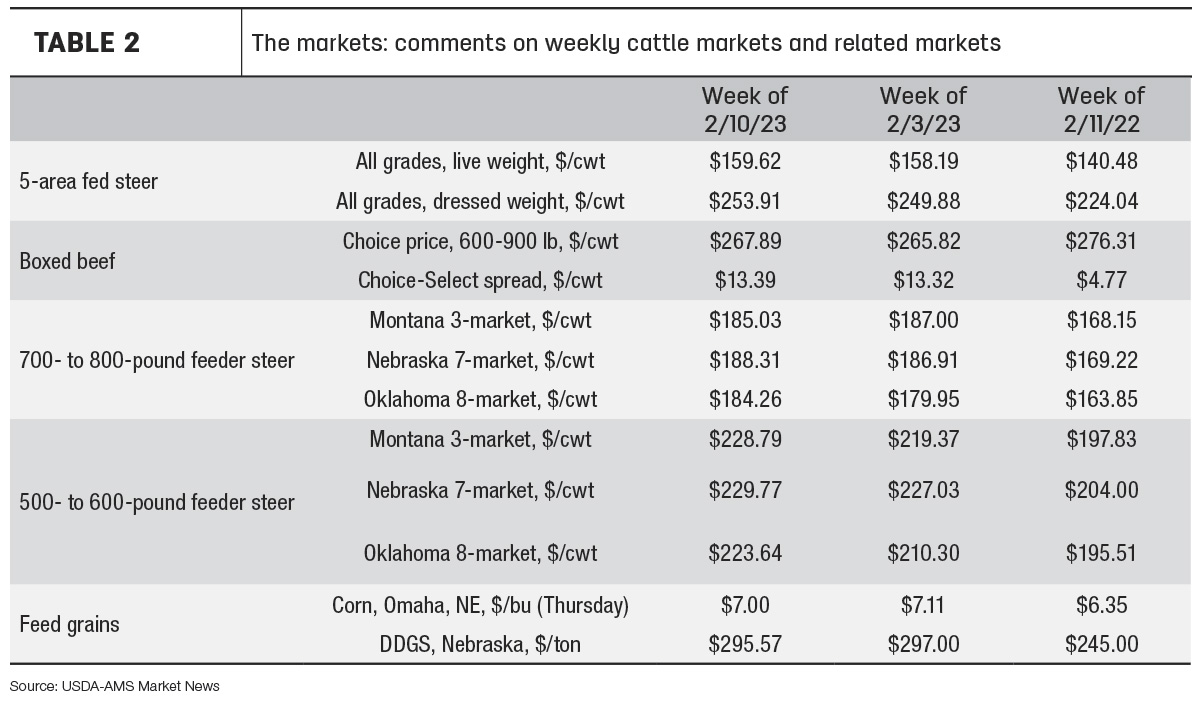The USDA Cattle Inventory report showed a 4% reduction in beef cows, a 6% decrease in heifers held back for retention and a 5% reduction in heifers expected to calve this year (USDA National Agricultural Statistics Service 2023). Feeder cattle supplies will be reduced nationally in 2023. Continued liquidation in 2023 will depend on the profit margins producers expect to receive.
Higher prices for feeder cattle are expected, but higher feed costs, especially hay, and other inputs are limiting the profit potential. Some producers have already run out of hay as heavy snow has limited winter grazing and persistent drought conditions shortened the grazing season and reduced overall hay production. Much has been said about the El Nino-Southern Oscillation (ENSO) weather patterns changing this year. If this weather pattern does materialize, the change will benefit the southern Plains with a cool and wet spring/summer whereas the Northern Plains generally stay dry in the summer before a cool/wet fall. For northern Plains cattle producers, it may get a bit tougher before things improve, from a feed perspective.
There will be producers who have feed resources and believe profits are to be had in 2023 and 2024. The quickest way for these producers to increase the feeder cattle supply is through the addition of bred cows or bred heifers. Bred heifers receive a premium over bred cows. For example, the price ratio of bred heifers to bred cows has averaged 2.5% over the last five years. In other words, bred heifers are on average 2.5% more expensive than bred cows. The premium is the widest in spring (March-May) and the lowest in fall (September-November). There is a premium due to the longer useful life of the cow in the herd, but it is smaller than expected due to potential issues with calving, which can occur with first-calf heifers.
However, the national bred cow price masks several factors that impact price. Age, weight, months bred, genetics and market conditions are the primary drivers of bred cow prices. One study using Oklahoma City bred heifer and bred cow sales from 2000-15 estimated the premiums and discounts for each of these factors in the bred cow market. To illustrate how these factors could impact producers' decisions to either buy or sell bred cows this year, I will discuss several scenarios assuming we have a 3-year-old bred cow that is six months pregnant, is a medium/large 1-2 and is black hided. February 2023 prices for this type of cow in Oklahoma City is $1,150 but has averaged $870 over the past three years.
Producers selling cows older than this should expect to receive a discount, and the discounts tend to decrease almost linearly from 0%-20% as cows age. A 4-year-old bred cow would cost $1,150 (0% discount), a 7-year-old bred cow would cost $1,035 (10% discount) and a 10-year-old bred cow would cost $920 (20% discount). Producers considering marketing older cows as bred should acknowledge the heavy discounts assigned as age increases.
Similarly, the closer the cow is to calving, the more expensive the bred cow becomes relative to a six-month-pregnant bred cow. Discounts and premiums are nearly linear between a 4% premium ($1,196) for an eight-month-pregnant bred cow, a 5% discount ($1,092) for a 4-month-pregnant bred cow and a 12% discount ($1,012) for a one-month-pregnant bred cow. These premiums and discounts exist as there is less risk of losing a calf as its age increases, lower production costs before the calf’s birth and revenue is received more quickly when late-gestating cows are purchased.
Selling this same bred cow at different times of the year will impact the price received. Producers looking to buy bred cows in the late winter or early spring should expect to pay a premium. The highest premiums are in February and March as many producers are purchasing cows that are on the same calving cycle in anticipation of summer grass and pastures. Prices peak in early March at approximately an 8% premium ($1,242). Prices are lowest – a 4% discount ($1,104) – in the summer and fall months in areas that are heavy spring calvers, as producers are culling their herds and determining which heifers to retain. Selling the same quality, age and pregnancy stage results in a difference of $138 per cow.

Current market conditions will also play a role in the price of bred cows. The feeder cattle and corn markets are the two largest drivers of bred cow prices. Higher feeder cattle prices create incentives for more calves to be brought to market, and bred cows are the quickest way to do so. Higher corn prices increase the cost of gain in feedlots. This puts downward pressure on feeder cattle prices, although the impact is delayed as it takes at least six to eight months before the potential calf will reach the feedlot. Combining these impacts and current price forecasts can show the premiums and discounts producers can expect to receive for a bred cow. Premiums and discounts are relative to our bred cow (3-year-old that is six months pregnant) and current Chicago Mercantile Exchange (CME) feeder cattle ($210 per hundredweight [cwt]) and corn ($6 per bushel) contracts. Table 1 shows these premiums and discounts. The nearby feeder cattle price at the time of sale has a much larger impact than the nearby corn price. For example, relative to the base, a 50-cent decline would increase the price of our bred cow by 0.77%, whereas a $10-per-cwt increase in the feeder cattle contract increases the price by 5.29%. Producers looking to rebuild herds through the bred cow market should be aware of these and other factors before buying or selling bred cows.










